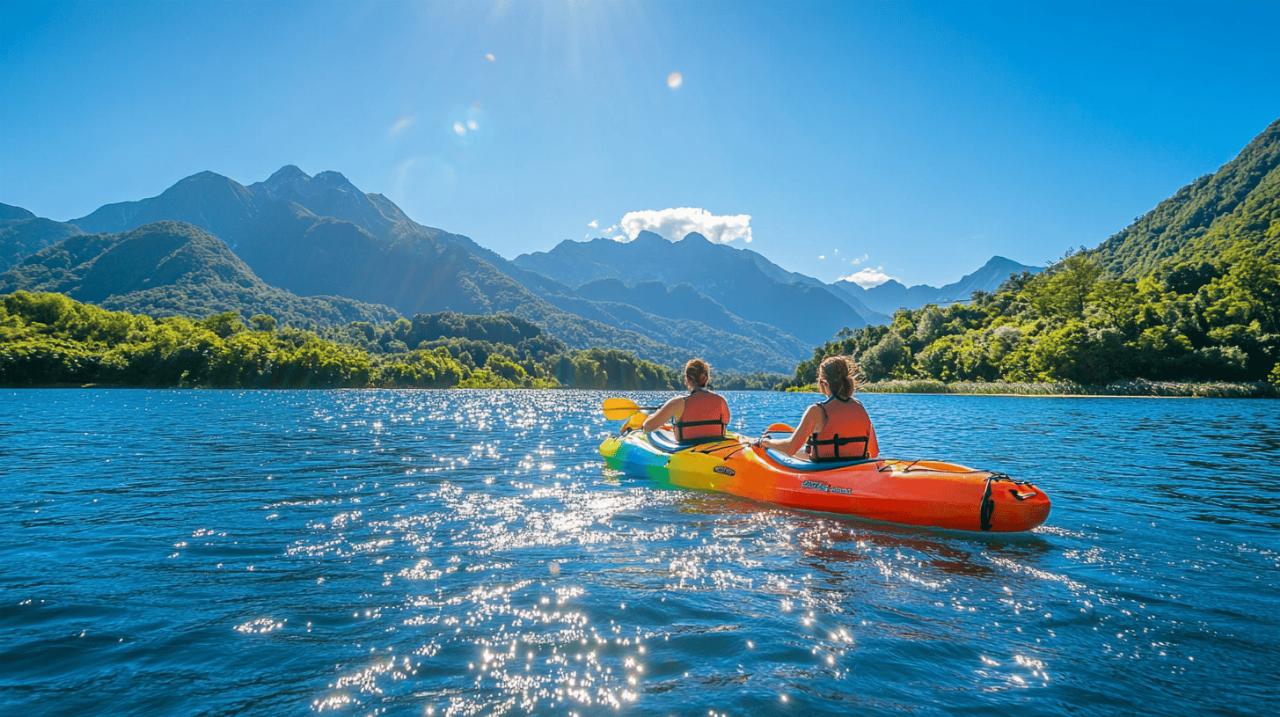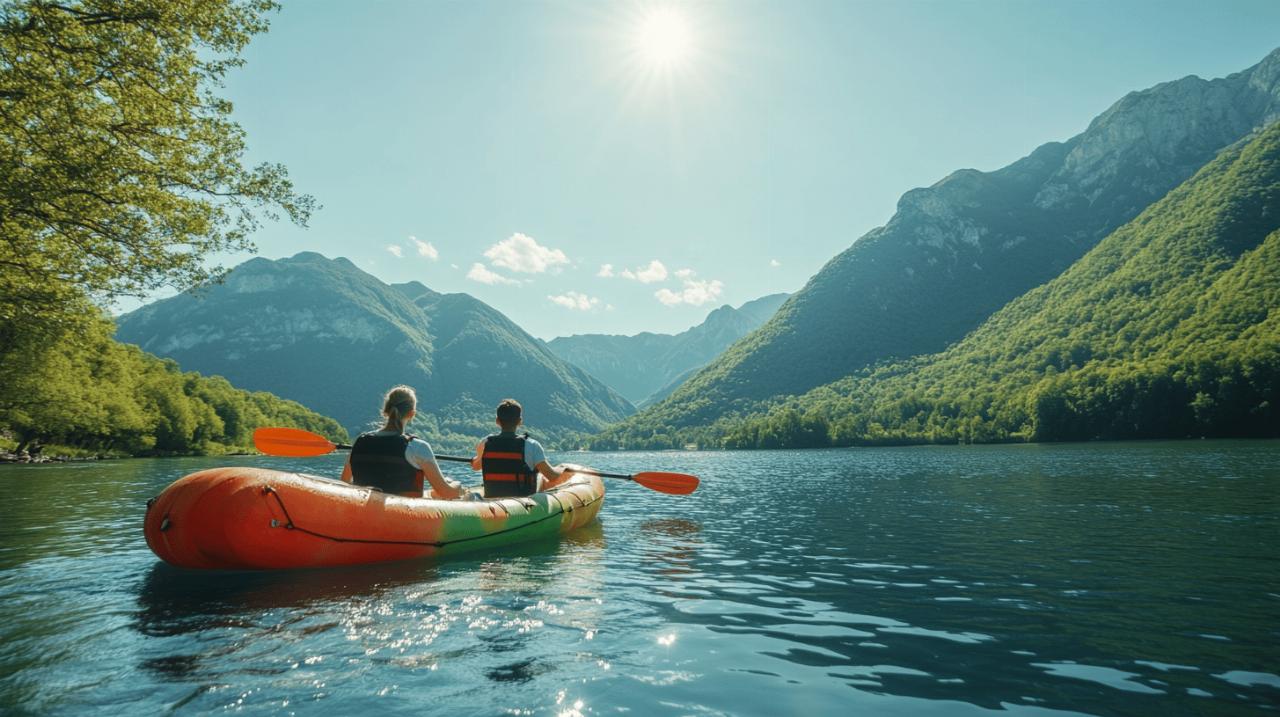Whether you're planning a serene paddle across a glassy lake or tackling gentle river currents with a mate, two-person inflatable kayaks have revolutionised the way we explore waterways. Gone are the days when inflatable meant flimsy pool toys; modern tandem inflatables now rival traditional hard-shell craft in performance whilst offering unmatched convenience. With advancements in materials and design, these versatile vessels have become the go-to choice for couples, families, and friends seeking aquatic adventures without the storage headaches or roof rack wrestling matches that come with rigid kayaks.
Understanding two-person inflatable kayaks: what makes them brilliant for tandem adventures
The appeal of two-person inflatable kayaks extends far beyond their ability to fold into a backpack. These remarkable watercraft combine portability with genuine performance, allowing paddlers to access remote waterways that would be impossible to reach with conventional kayaks. The modern tandem inflatable serves multiple purposes, from peaceful lake exploration to fishing expeditions, and even whitewater adventures for the more adventurous souls. What truly sets them apart is the freedom they provide; you can store them in a cupboard under the stairs, transport them on public transport, or simply chuck them in the boot without requiring specialist vehicle modifications. This accessibility has opened paddling to countless people who previously found the logistics of kayak ownership simply too daunting.
The Evolution of Inflatable Kayak Technology: Drop Stitch Construction and Performance Enhancements
The technological leaps in inflatable kayak construction have been nothing short of remarkable. Drop stitch technology represents the crown jewel of these innovations, creating floors that inflate to extraordinary rigidity by connecting the top and bottom layers of material with thousands of individual threads. This construction method transforms what was once a somewhat wobbly inflatable into a craft with hull stiffness approaching that of hard-shell kayaks. When properly inflated to the recommended pressure, these floors become surprisingly solid underfoot, dramatically improving both tracking and speed through the water. Beyond drop stitch floors, manufacturers have incorporated aluminium ribs into their designs, particularly visible in models like the Advanced Elements AdvancedFrame Convertible Elite. These skeletal frameworks work in concert with the inflated chambers to provide exceptional directional stability whilst maintaining the packability that makes inflatables so attractive. High-density materials now replace the pool toy fabrics of yesteryear, with puncture-resistant PVC construction becoming standard on quality models. Multiple air chambers ensure that even if one section fails, the kayak remains afloat and functional, a crucial safety feature for anyone venturing beyond swimming distance from shore.
Inflatable vs Hard-Shell: Why Tandem Inflatables Are Perfect for Weekend Warriors
The debate between inflatable and rigid kayaks has shifted considerably as inflatable technology has matured. For the occasional paddler or those without dedicated storage space, the choice increasingly favours inflatables. Consider the practicalities: a hard-shell tandem kayak requires roof bars, careful lifting by two people, and either garage space or outdoor storage that invites deterioration from weather and ultraviolet exposure. Contrast this with an inflatable that packs down to roughly the size of a large rucksack, can be inflated in minutes using a foot pump, and stores happily in a wardrobe between adventures. For urban dwellers or those living in flats, this difference proves decisive. Performance comparisons reveal that premium inflatables now match their rigid counterparts in most recreational scenarios. They excel on calm waters, handle moderate river currents admirably, and even venture into coastal bays when conditions permit. The slightly reduced top speed compared to racing kayaks matters little for leisure paddling, where the journey matters more than breakneck pace. Stability often exceeds that of hard-shell kayaks due to the wider beam common in inflatable designs, making them particularly confidence-inspiring for novice paddlers or those introducing children to the sport.
Our Top 7 Two-Person Inflatable Kayaks for 2025: Complete Reviews and Comparisons
Selecting the ideal tandem inflatable requires balancing numerous factors including intended use, budget constraints, and the specific water conditions you'll encounter most frequently. The market offers everything from basic recreational models perfect for occasional lake paddles to sophisticated expedition kayaks capable of multi-day backcountry adventures. Understanding where each model excels helps ensure your investment delivers years of satisfying service rather than gathering dust after initial enthusiasm wanes. The following selections represent the cream of what's currently available, spanning price points and specialisations to suit varied paddling ambitions.
Premium performance models: aqua marina tomahawk air-k 440 and advanced elements advancedframe convertible elite
When performance matters most and budget permits, the Aqua Marina Tomahawk Air-K 440 stands as a remarkable achievement in inflatable kayak engineering. Its drop stitch construction throughout delivers extraordinary rigidity, transforming the paddling experience into something closely approximating a rigid touring kayak. The investment required reflects this quality, with prices hovering around the thousand-pound mark, but serious paddlers consistently praise its tracking ability and gliding efficiency. This kayak truly comes into its own during extended sessions on larger lakes or sheltered coastal waters where its superior speed and directional stability shine. The construction quality inspires confidence in varied conditions, though its premium positioning means it's perhaps excessive for those planning only occasional gentle paddles. The Advanced Elements AdvancedFrame Convertible Elite occupies similar territory in terms of quality and price, offering a distinctive hybrid design that incorporates aluminium ribs for enhanced hull definition. Measuring an impressive fourteen feet eleven inches when inflated, it provides ample room for two adults plus gear, with a weight capacity reaching five hundred and fifty pounds. The convertible aspect allows transformation between tandem and solo configurations, adding versatility that justifies the investment for households where paddling partners aren't always available. Setup requires a bit more effort than simpler designs due to the frame assembly, but the resulting performance rewards this additional preparation. The tracking and speed rival many rigid kayaks, making longer tours genuinely enjoyable rather than exhausting slogs against wayward drift.
Budget-friendly champions: intex challenger k2 and hydro-force cove champion set
Not everyone requires expedition-grade equipment, and the Intex Challenger K2 has earned its reputation as the sensible entry point into tandem kayaking. Priced at a fraction of premium models, it delivers respectable performance for calm water exploration whilst remaining genuinely portable at just over seventeen kilogrammes. The straightforward design features bright colours for visibility, inflatable seats providing reasonable comfort, and simple valves that make setup and deflation relatively painless. Experienced paddlers note its limitations in wind or current, where the lightweight construction and modest length result in frustrating drift, but for sheltered lakes on calm days it performs admirably. The complete package includes paddles and a pump, eliminating the need for additional purchases that can quickly inflate the true cost of seemingly cheaper alternatives. Families particularly appreciate its forgiving stability, allowing children to shift about without inducing panic, though the weight capacity of one hundred and eighty-one kilogrammes requires sensible loading to avoid sitting too low in the water. The Hydro-Force Cove Champion Set similarly targets budget-conscious paddlers seeking occasional recreation rather than regular expeditions. Its construction prioritises affordability, resulting in materials that demand careful treatment to avoid premature failure, but for those uncertain whether kayaking will become a lasting interest, it represents a reasonable trial investment. The set includes everything needed to get on the water immediately, removing barriers that might otherwise delay those first crucial outings when enthusiasm runs highest. Inflation speed impresses given the price point, though the resulting floor firmness falls short of premium alternatives, creating a slightly less responsive paddling platform that becomes more noticeable as skills develop.
Essential factors when choosing your tandem inflatable kayak
 Beyond reviewing specific models, understanding the fundamental considerations that should guide your selection ensures the kayak you choose genuinely matches your requirements rather than disappointing through mismatched expectations. The variety available means nearly every paddling scenario has an ideal solution, but finding it requires honest assessment of your typical usage patterns, storage limitations, and performance priorities. Getting these decisions right prevents the common pitfall of outgrowing an initial purchase too quickly or, conversely, overspending on capabilities you'll never actually utilise.
Beyond reviewing specific models, understanding the fundamental considerations that should guide your selection ensures the kayak you choose genuinely matches your requirements rather than disappointing through mismatched expectations. The variety available means nearly every paddling scenario has an ideal solution, but finding it requires honest assessment of your typical usage patterns, storage limitations, and performance priorities. Getting these decisions right prevents the common pitfall of outgrowing an initial purchase too quickly or, conversely, overspending on capabilities you'll never actually utilise.
Weight Capacity, Transport Convenience, and Storage Considerations for Two-Person Kayaks
Weight capacity specifications warrant careful attention despite temptation to treat them as conservative manufacturer caution. A kayak rated for two hundred kilogrammes will technically float two large adults, but performance deteriorates markedly when approaching maximum capacity, with the craft sitting lower in the water and responding sluggishly to paddle strokes. Sensible practice suggests staying at least twenty percent below stated capacity to maintain responsive handling and adequate freeboard in even modest waves. Factor in not just paddler weight but also the accumulation of safety equipment, snacks, waterproof bags containing dry clothes, and perhaps fishing gear or photography equipment if those activities feature in your plans. Transport convenience extends beyond just weight, encompassing packed dimensions and the quality of included carry bags. A kayak weighing fifteen kilogrammes remains manageable for most people when properly bagged, but one approaching twenty-five kilogrammes may require two people to lift comfortably, limiting spontaneous solo trips. The compactness of the packed bundle determines whether it fits in a conventional car boot alongside other luggage or demands the entire space, potentially complicating multi-activity holidays. Quality carry bags feature padded shoulder straps and robust construction rather than flimsy affairs that split after a season, making the difference between a kayak you actually use and one that seems too much bother to retrieve. Storage at home varies from genuinely compact models fitting into standard cupboards to bulkier packages requiring dedicated garage or shed space, bringing you almost back to hard-shell storage challenges if you're not careful in your selection.
Matching Your Kayak to Water Conditions: Lakes, Rivers, and Coastal Waters
Different water environments demand different hull characteristics, making intended usage the primary determining factor in kayak selection. Calm lakes and sheltered bays forgive nearly any design, allowing budget models to perform adequately whilst premium craft feel somewhat underutilised, making this the ideal environment for beginners or occasional paddlers. Rivers introduce current and potentially obstacles, requiring more robust construction and better manoeuvrability than lake-focused designs provide. Look for reinforced materials capable of surviving the occasional scrape against submerged rocks, plus hull shapes that turn responsively when navigating around obstacles becomes necessary. Coastal waters present the most demanding conditions, with wind, waves, and potential tidal currents requiring kayaks with superior tracking, adequate length for wave handling, and construction quality that inspires confidence when shore sits further away than comfortable swimming distance. British conditions add specific considerations, particularly the changeable weather that can transform benign morning conditions into challenging afternoon scenarios. Wind affects inflatable kayaks more than rigid craft due to their typically higher profile, making larger lakes surprisingly difficult on breezy days even when wave height remains modest. Checking forecasts becomes non-negotiable, with particular attention to wind speed and direction rather than just precipitation. Route planning should account for your realistic capabilities in less-than-ideal conditions, avoiding the temptation to venture too far from shore or launch points during initial outings when your skills and the kayak's characteristics remain relatively unfamiliar.
Getting the Most from Your Two-Person Inflatable Kayak: Maintenance and Accessories
Ownership extends beyond the initial purchase, encompassing proper care that maximises lifespan alongside accessories that enhance safety and convenience. Quality inflatable kayaks easily provide many seasons of reliable service when treated with appropriate respect, whilst neglect or improper storage can lead to premature deterioration that seems to strike suddenly but actually results from accumulated mistreatment. Understanding proper maintenance practices and essential supplementary equipment transforms ownership from potentially frustrating to genuinely rewarding.
Proper Inflation, Repair Kits, and Pump Selection for Optimal Performance
Achieving correct inflation pressure proves crucial for performance yet remains commonly misunderstood by novice owners. Under-inflation creates a mushy kayak that flexes excessively, wasting energy and compromising tracking, whilst over-inflation risks damaging seams or even catastrophic failure, particularly when hot sun warms air inside chambers causing expansion. Most quality kayaks specify pressure ratings for each chamber, often expressed in pounds per square inch or bar, requiring a pump with an integrated pressure gauge to monitor accurately. Hand pumping to these pressures demands considerable effort, making an efficient dual-action foot pump a worthwhile investment that pays dividends in reduced setup time and sustained enthusiasm when multiple inflation sessions don't leave you exhausted before paddling begins. The superior option involves electric pumps designed for inflatable watercraft, transforming setup from aerobic exercise into relaxed waiting, though they introduce dependence on either vehicle power sockets or battery capacity requiring management. Repair kits deserve more attention than the cursory glance they typically receive, with quality kits including not just patches but also valve tools and comprehensive adhesive. Familiarising yourself with repair procedures before problems arise prevents panic when a small puncture threatens to curtail a trip, and carrying a kit on every outing provides insurance against mishaps far from vehicle access. Most repairs prove straightforward when tackled calmly, involving thorough cleaning of the damaged area, proper adhesive application, and adequate curing time before reinflation, turning potentially trip-ending disasters into minor inconveniences.
Essential Accessories and Safety Gear for Tandem Paddling Adventures
Safety equipment begins with proper buoyancy aids for every paddler, regardless of swimming ability or water depth. Modern aids designed specifically for paddling offer superior comfort and freedom of movement compared to generic lifejackets, with features like large armholes preventing chafing during the repetitive motions of paddle strokes. British Canoeing Waterways Licence requirements apply to many rivers and canals, making membership worthwhile for regular paddlers both for legal access and the third-party insurance coverage included. Beyond regulatory requirements, practical accessories enhance comfort and convenience significantly. Dry bags in various sizes protect valuables, spare clothing, and snacks from inevitable splashes or the occasional capsize, with bright colours aiding retrieval if they somehow escape the kayak. Paddle leashes prevent loss of paddles during moments when both hands are needed for other tasks, whilst kayak leashes secure the craft when briefly stepping out in shallow water. Additional storage options like deck bags provide convenient access to items needed frequently, avoiding the need to unpack dry bags repeatedly. Consider sun protection seriously, including broad-spectrum sunscreen, wide-brimmed hats, and lightweight long-sleeved shirts, as the reflection from water intensifies exposure beyond what land-based activities create. A simple first aid kit tailored to water activities, whistle for attracting attention if needed, and mobile phone in a waterproof case complete a sensible safety ensemble. For those planning extended trips or venturing into more remote locations, informing someone of your intended route and expected return time provides crucial backup should problems arise, transforming a potentially serious situation into merely an inconvenient rescue.





